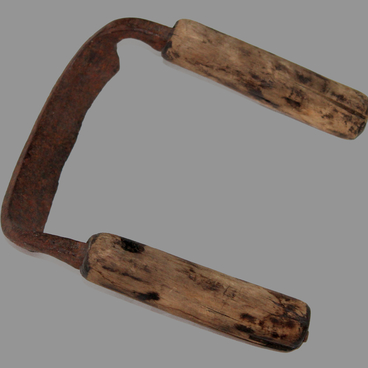Planes were essential in the construction of oil field facilities in the village of Ishimbaevo in the 1930s, and are still a highly widespread woodworking tool to this day. Collection of the Ishimbay Museum of History and Local Lore contains an example of a simple wooden single-blade hand plane like the ones used by Ishimbay construction workers and carpenters.
Planes are used for flattening wood surfaces after sawing or after treating them with the jack plane, a tool for the initial rough dressing of boards. The cutting edge of the plane blade is straight and slightly rounded at the corners in order to prevent it from leaving marks when planing wood surfaces. However, the absence of the special component known as the chipbreaker or the cap iron in a plane can sometimes result in the jagging, tearing, or chipping of the worked surface. The blade extends about 1 mm beyond the base of the plane.
The plane still remains one of the most popular tools among both professional and amateur woodworkers. It comes in a great variety of types. Some of them are no longer in use today, but it is still quite interesting to know how the planes used by the craftsmen of old looked and what possibilities they could offer. In the late 19th century, carpenters distinguished four types of planes based on their country of origin: these included English, German, French, and American planes. The most widespread type in Russia was the German plane. Even the Russian word for ‘the plane, ’ ‘rubanok, ’ as well as the names of all other tools of this kind (including ‘the jointer plane, ’ or ‘fuganok’; ‘the shoulder plane’, or ‘zenzubel’; ‘the rebate plane’, or ‘falzgebel’; and many others) come from German.
German and French planes did not differ much from the models commonly found in Russia. The English plane had a wider and shorter body with rounded sides for lighter weight and easier grip. The opening in the bottom part of the tool’s body was moved forward and positioned at an angle, greatly facilitating its use. American planes often had cast iron bodies with a carefully polished front side. The main advantage of metal planes was their highly practical and convenient way of securing the blade with screws and springs, rather than a wedge, an additional piece that had to be hammered into the plane with a mallet.
However, American planes had their drawbacks: cast iron tools were heavy to move, and the friction of cast iron on wood was greater than that of wood on wood. To overcome this disadvantage, manufacturers reduced the area of the friction surface and the tool’s weight. This was achieved by replacing cast-iron bodies with wooden ones, leaving only small metal inserts for securing the blade.
Planes are used for flattening wood surfaces after sawing or after treating them with the jack plane, a tool for the initial rough dressing of boards. The cutting edge of the plane blade is straight and slightly rounded at the corners in order to prevent it from leaving marks when planing wood surfaces. However, the absence of the special component known as the chipbreaker or the cap iron in a plane can sometimes result in the jagging, tearing, or chipping of the worked surface. The blade extends about 1 mm beyond the base of the plane.
The plane still remains one of the most popular tools among both professional and amateur woodworkers. It comes in a great variety of types. Some of them are no longer in use today, but it is still quite interesting to know how the planes used by the craftsmen of old looked and what possibilities they could offer. In the late 19th century, carpenters distinguished four types of planes based on their country of origin: these included English, German, French, and American planes. The most widespread type in Russia was the German plane. Even the Russian word for ‘the plane, ’ ‘rubanok, ’ as well as the names of all other tools of this kind (including ‘the jointer plane, ’ or ‘fuganok’; ‘the shoulder plane’, or ‘zenzubel’; ‘the rebate plane’, or ‘falzgebel’; and many others) come from German.
German and French planes did not differ much from the models commonly found in Russia. The English plane had a wider and shorter body with rounded sides for lighter weight and easier grip. The opening in the bottom part of the tool’s body was moved forward and positioned at an angle, greatly facilitating its use. American planes often had cast iron bodies with a carefully polished front side. The main advantage of metal planes was their highly practical and convenient way of securing the blade with screws and springs, rather than a wedge, an additional piece that had to be hammered into the plane with a mallet.
However, American planes had their drawbacks: cast iron tools were heavy to move, and the friction of cast iron on wood was greater than that of wood on wood. To overcome this disadvantage, manufacturers reduced the area of the friction surface and the tool’s weight. This was achieved by replacing cast-iron bodies with wooden ones, leaving only small metal inserts for securing the blade.



